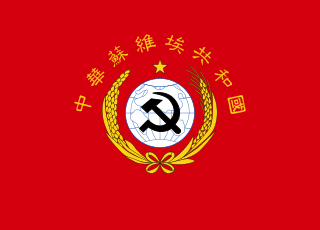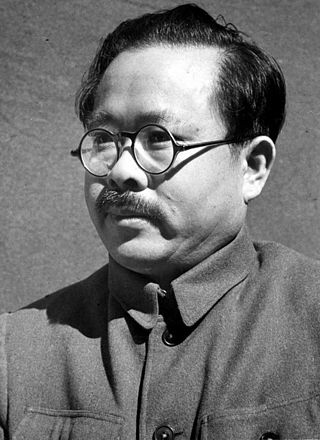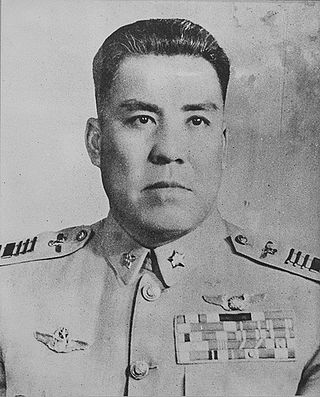Related Research Articles

The Long March was a military retreat by the Chinese Red Army from advancing Nationalist forces during the Chinese Civil War in 1934 through 1936.

The Chinese Soviet Republic (CSR) was a state within China, proclaimed on 7 November 1931 by Chinese Communist Party (CCP) leaders Mao Zedong and Zhu De in the early stages of the Chinese Civil War. The discontiguous territories of the CSR included 18 provinces and 4 counties under the communists' control. The CSR's government was located in its largest component territory, the Jiangxi Soviet. Due to the importance of the Jiangxi Soviet in the CSR's early history, the name "Jiangxi Soviet" is sometimes used to refer to the CSR as a whole. Other component territories of the CSR included the Northeastern Jiangxi, Hunan-Jiangxi, Hunan-Hubei-Jiangxi, Hunan-Western Hubei, Hunan-Hubei-Sichuan-Guizhou, Eyuwan, Shaanxi-Gansu, Sichuan-Shanxi, and Haifeng-Lufeng Soviets.

Zhang Guotao, or Chang Kuo-tao, was a founding member of the Chinese Communist Party (CCP) and rival to Mao Zedong. During the 1920s he studied in the Soviet Union and became a key contact with the Comintern, organizing the CCP labor movement in the United Front with the Kuomintang. From 1931 to 1932, after the Party had been driven from the cities, Zhang was placed in charge of the Eyuwan Soviet. When his armies were driven from the region, he joined the Long March but lost a contentious struggle for party leadership to Mao Zedong. Zhang's armies then took a different route from Mao's and were badly beaten by local Muslim Ma clique forces in Gansu. When his depleted forces finally arrived to join Mao in Yan'an, Zhang continued his losing challenge to Mao, and left the party in 1938. Zhang eventually retired to Canada, in 1968. He became a Christian shortly before his death in Scarborough, Ontario, in 1979. His memoirs provide valuable and vivid information on his life and party history.

He Long was a Chinese Communist revolutionary and a Marshal of the People's Republic of China. He was from a poor rural family in Hunan, and his family was not able to provide him with any formal education. He began his revolutionary career after avenging the death of his uncle, when he fled to become an outlaw and attracted a small personal army around him. Later his forces joined the Kuomintang, and he participated in the Northern Expedition.
The first encirclement campaign can refer to one of several encirclement campaigns launched during the 1930s by the Nationalist Government of China against the Chinese soviets created by the Chinese Communist Party. These include:
The encirclement campaign against the Hunan-Jiangxi Soviet was an encirclement campaign launched by the Nationalist government against the Communist Party of China's Hunan-Jiangxi Soviet. The Chinese Red Army successfully defended the Soviet against the Nationalist attacks from January 29 to March 24, 1931.

The encirclement campaign against the Hunan-Hubei-Jiangxi Soviet was a military campaign launched by the Kuomintang Nationalist Government against the communist Soviet force in the Hunan-Hubei-Jiangxi. It was responded to with the Communists' Counter-encirclement campaign at the Hunan-Hubei-Jiangxi Soviet, also called their Counter-encirclement campaign at the Hunan-Hubei-Jiangxi Revolutionary Base. The local red army successfully defended this soviet republic against the government attacks from December 1930 through to May 1931.

The Jiangxi Soviet was a soviet governed by the Chinese Communist Party (CCP) that existed between 1931 and 1934. It was the largest component of the Chinese Soviet Republic and home to its capital, Ruijin. At the time, the CCP was engaged in a rural insurgency against the Kuomintang-controlled Nationalist Government as part of the Chinese Civil War. CCP leaders Mao Zedong and Zhu De chose to create the soviet in the rugged Jinggang Mountains on the border of Jiangxi and Fujian because of its remote location and defensible terrain. The First Red Front Army successfully repulsed a series of encirclement campaigns by the Kuomintang's National Revolutionary Army (NRA) during the first few years of the Soviet's existence, but they were eventually defeated by the NRA's fifth attempt in 1934-35. After the Jiangxi Soviet was defeated militarily, the CCP began the Long March towards a new base area in the northwest.
The Hunan–Jiangxi Soviet was a constituent part of the Chinese Soviet Republic, an unrecognised sovereign state that existed from November 1931 to 1935. Before that declaration of overarching statehood, the area was known as the Hunan-Jiangxi Revolutionary Base.

The Hunan–Hubei–Jiangxi Soviet was a Comintern and local communist-led liberated zone in the 1930s south of the Yangtze River, comprising parts of counties in what are now the municipal regions of Yueyang in Hunan, Xianning in Hubei and, in Jiangxi, Jiujiang and Yichun. It was a constituent part of the territorially discontiguous and diplomatically unrecognised Chinese Soviet Republic (CSR). Before the declaration of the CSR in November 1931, the liberated zone had been known to Communists as the Hunan-Hubei-Jiangxi (Xiang-E-Gan) Revolutionary Base Area (湘鄂赣革命根据地).
The second encirclement campaign against the Honghu Soviet was an encirclement campaign launched by the Chinese Nationalist Government that was intended to destroy Chinese Communist Party's Honghu Soviet and its Chinese Red Army. The Red Army successfully defended their soviet republic against Nationalist attacks from 1 March, 1931 to early June, 1931.

The fifth encirclement campaign against the Jiangxi Soviet was a series of battles fought during the Chinese Civil War from 25 September 1933, to October 1934 between Chiang Kai-shek's Chinese Nationalists (Kuomintang) and the Chinese Communists. During this campaign, the Kuomintang successfully overran the communist Chinese Soviet Republic and forced the Communists on the run, an event later known as the Long March.
The fourth encirclement campaign against the Eyuwan Soviet was an encirclement campaign launched by the Chinese Nationalist Government against the Communist base in the border region between Hubei, Henan, and Anhui provinces, the Eyuwan Soviet. Although the Fourth Red Army responded with its fourth counter-encirclement campaign, the Nationalists were ultimately successful and overran the soviet area by early October 1932.

Ren Bishi was a military and political leader in the early Chinese Communist Party (CCP).

Communist-controlled China or the Revolutionary Base Area, officially called the Soviet Zone from 1927 to 1937, and the Liberated Zone from 1946 to 1949, was the part of the territories of China controlled by the Soviet-backed Chinese Communist Party (CCP) from 1927 to 1949 during the Republican era and the Chinese Civil War with Nationalist China.

The Chinese Red Army, formally the Chinese Workers' and Peasants' Red Army or just the Red Army, was the military wing of the Chinese Communist Party from 1928 to 1937. It was formed when Communist elements of the National Revolutionary Army splintered and mutinied in the Nanchang Uprising. The Red Army was reincorporated into the National Revolutionary Army as part of the Second United Front with the Kuomintang to fight against the Japanese during the Second Sino-Japanese War of 1937–1945. In the later stages of the Chinese Civil War they splintered off once again and renamed the People's Liberation Army.

Xia Douyin (1885–1951) was a Republic of China National Revolutionary Army general. He was born in Macheng, Hubei. Originally a member of the Qing Dynasty New Army, he participated in the Xinhai Revolution of 1911. In 1917, he joined the Constitutional Protection Movement and opposed local warlord Wang Zhanyuan. Defeated by Wang's forces, he fled to Changsha and enlisted the help of allies in Hunan against Wang. After suffering another defeat in 1919, he fled to the border region of Hunan and Jiangxi Provinces. In 1926, he was brought by Tang Shengzhi into the National Revolutionary Army and participated in the Northern Expedition as a divisional commander. On May 17, 1927, Xia led Kuomintang forces loyal to Chiang Kai-shek from Yichang against the forces of Ye Ting in Wuhan. After his victory, he notoriously took personal pleasure in mutilating the corpses of female revolutionaries he had killed. Chiang promoted Xia to army commander and he fought in the Central Plains War of 1930. Xia was then tasked with suppressing the Eyuwan Soviet in the border region between Hubei, Henan, and Anhui provinces. He ordered the massacre of thousands of civilians but was unable to stop the Communists' expansion. In 1932, Xia was promoted to full general and made governor of Hubei, although Zhang Qun actually acted in his place. From July to September 1932, Chiang Kai-shek ordered 300,000 troops of the National Revolutionary Army to surround and suppress the Eyuwan Soviet in the Fourth Encirclement Campaign. Xia directed a scorched earth campaign, killing all men found in the Soviet areas, burning all buildings, and seizing or destroying all crops. He was ultimately successful and the main Communist Red Army was forced to retreat westwards. During the Second Sino-Japanese War, Xia fled to Chengdu after Hubei was occupied by the invading Imperial Japanese Army. In 1945, he retired from the military. Although he attempted to welcome the Chinese Communist Party (CCP) takeover of the mainland, the CCP rebuffed him and he fled to Hong Kong, where he died.

Wang Shuming was a Colonel general of the Republic of China Air Force. He was born in Town of Xiangzhou, Zhucheng, Shandong, China.
The Eyuwan Soviet was a short-lived soviet government established in March 1930 by the Chinese Communist Party in the Dabie Mountains border region between Hubei, Henan, and Anhui provinces. At its height in 1931 and early 1932, the Eyuwan Soviet was the second-largest Chinese Soviet after the Central Soviet in Jiangxi. It improved the rights of women and redistributed land to poor and landless peasants. It was famously led by Zhang Guotao, a rival of Mao Zedong, who attempted to consolidate his control over Eyuwan with a series of purges. The Fourth Nationalist Encirclement Campaign defeated Eyuwan's Fourth Red Army in late 1932 and forced it to retreat westwards towards Sichuan and Shaanxi. The Soviet government ceased to function and the Communists retreated into the mountains. Despite several extermination campaigns intended to flush them out, the region remained a hotbed of Communist guerrilla activity until a truce was established in the Chinese Civil War.
The following is a topical outline of English Wikipedia articles about the history of the Chinese Civil War (1912–1949)
References
Citations
Sources
- Opper, Marc (2020). People's Wars in China, Malaya, and Vietnam. Ann Arbor, Michigan, USA: University Of Michigan Press. ISBN 978-0-472-12657-6.
- Hsu, Wilbur W. (2012). Survival Through Adaptation: The Chinese Red Army and the Extermination Campaigns, 1927-1936 (PDF). Art of War Papers. Combat Studies Institute Press.
{{cite book}}: Text "Fort Leavenworth, Kansas, USA" ignored (help)